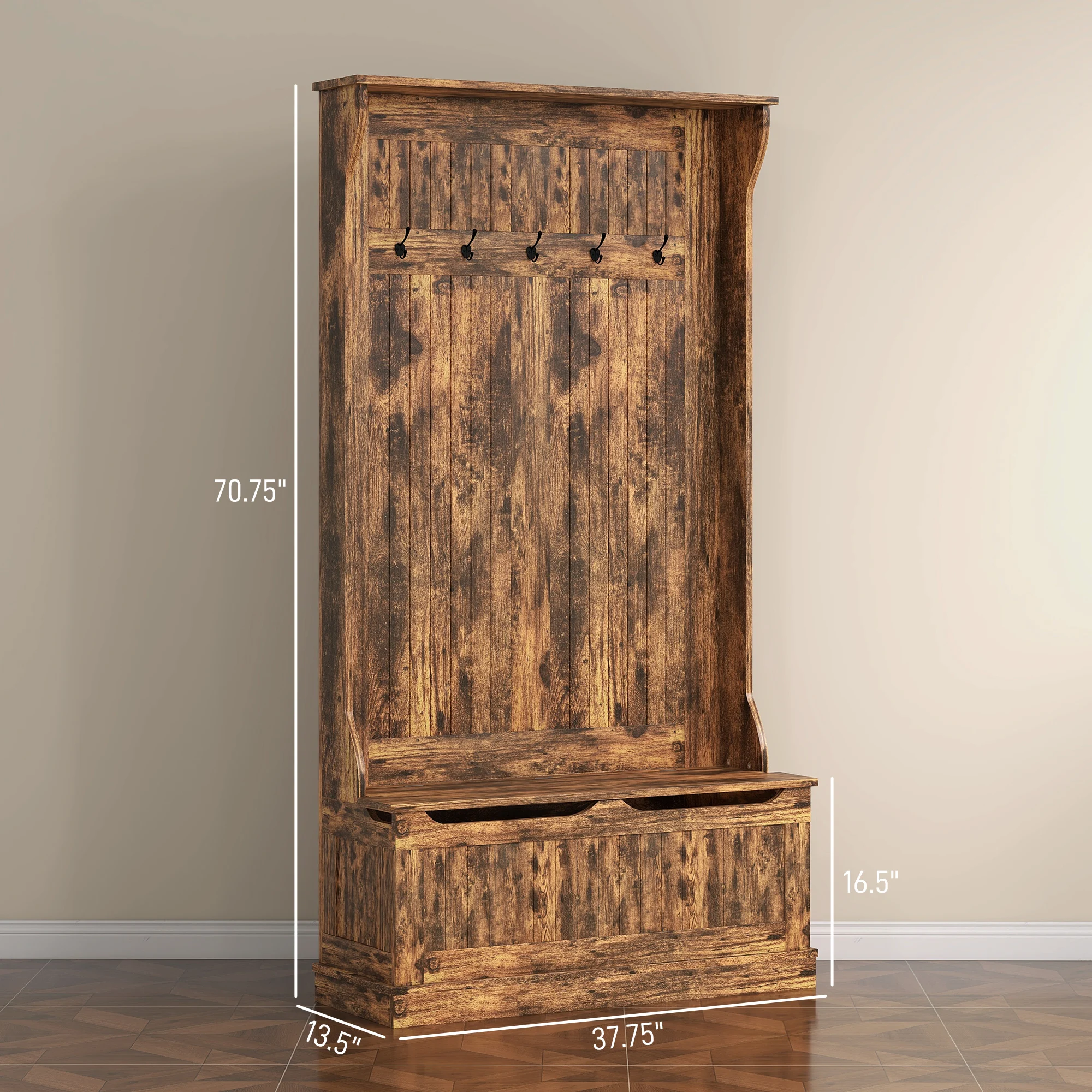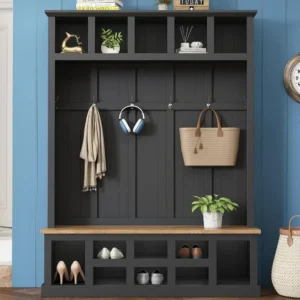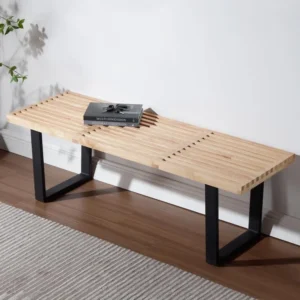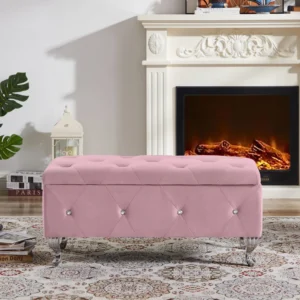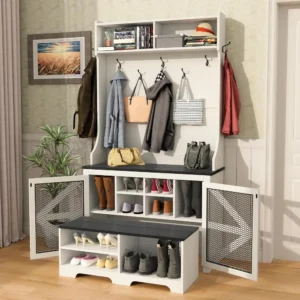Introduction: The Enduring Appeal of Rustic Entry Furniture
The moment someone steps through your front door, they get an immediate sense of your home’s character and style. Rustic entry furniture creates that perfect first impression – warm, inviting, and timelessly appealing. But what exactly makes furniture “rustic”? At its core, rustic style celebrates natural materials, expert craftsmanship, and finishes that highlight rather than hide imperfections. It’s furniture with a story to tell.
Rustic entry pieces remain enduringly popular because they bring warmth and character to what might otherwise be a purely functional space. The rich textures of natural wood, the sturdy construction, and the weathered finishes create an immediate sense of comfort and welcome. This style has evolved from its humble origins in mountain cabins and countryside cottages to become a versatile design choice that works beautifully in various home styles.
In this comprehensive guide, we’ll explore everything you need to know about selecting the perfect rustic entry furniture that balances beauty with practicality. As Nested Goods believes, this is where “Function Meets Style” – creating entryway pieces that not only look stunning but serve your everyday needs beautifully.
If you’re looking for inspiration before diving into the selection process, exploring different rustic farmhouse bench designs can help you visualize possibilities for your own space.
Understanding the Essentials of Rustic Style for Entryways
Rustic style is defined by several key elements that give it its distinctive character and appeal:
Materials:
– Solid woods like oak, pine, walnut, and cedar
– Reclaimed timber with history and character
– Wrought iron accents and hardware
– Natural stone elements
Textures and Finishes:
– Distressed surfaces that showcase wear
– Hand-scraped or wire-brushed textures
– Weathered patinas that tell a story
– Raw edges that highlight the natural form of wood
Construction Techniques:
– Visible joinery that celebrates craftsmanship
– Handcrafted details rather than machine precision
– Sturdy builds with substantive presence
– Traditional woodworking methods
Color Palette:
– Earth tones that reflect natural materials
– Warm neutrals that create an inviting atmosphere
– Natural wood hues ranging from honey to deep walnut
– Occasional pops of muted color in accessories
What makes rustic style so welcoming is its authenticity – these pieces don’t try to be perfect. Their character comes from natural variations, visible craftsmanship, and a connection to traditional building methods.
Several rustic sub-styles exist, each with their own character. Cabin rustic features heavier woods and lodge-inspired elements, while Spanish rustic incorporates terracotta tones and wrought iron. Industrial-rustic blends raw woods with metal elements for a more contemporary edge.
Creating your dream rustic entryway involves understanding these fundamental elements and choosing pieces that reflect your preferred interpretation of rustic style. For a more specific direction, exploring farmhouse entryway bench options can provide inspiration for a particular rustic aesthetic that remains extremely popular.
Essential Rustic Entry Furniture Pieces: Finding Your Perfect Match
Console Tables
The console table often serves as the anchor piece in an entryway. Rustic versions typically feature:
– Slim profiles that don’t obstruct traffic flow
– Lower shelves or drawers for additional storage
– Substantial tops for displaying decorative items and essentials
Ideal for: Entryways with wall space but limited floor area; homes needing a dedicated spot for mail, keys, and other small items.
Entry Benches
A practical addition that provides seating while putting on or removing shoes:
– Various storage configurations (open shelves, hidden storage, shoe racks)
– Different materials from all-wood construction to wood frames with upholstered seats
– Lengths ranging from compact two-person to extended family-size options
Ideal for: Active households where having a place to sit while dealing with footwear is appreciated; entryways that need to accommodate multiple family members.
Hall Trees
These multi-functional pieces combine several elements into one unit:
– Bench seating with storage below
– Vertical storage with hooks for coats, bags, and hats
– Often include mirrors and additional shelving
– Some feature shoe storage in lower compartments
Ideal for: Homes without separate coat closets; families needing an organizational hub; entryways that need to maximize functionality in limited space.
Storage Cabinets
More substantial storage solutions that keep clutter contained:
– Concealed storage behind doors for a cleaner look
– Various heights from knee-wall to full-height options
– Interior organization systems for specific storage needs
– Often feature decorative tops for displaying welcome accents
Ideal for: Households with significant storage needs; entryways that serve as transition spaces for seasonal items; homes where visible storage isn’t preferred.
Decorative Accents
These finishing touches complete the rustic entryway look:
– Mirrors with rustic frames to amplify light and create depth
– Wall-mounted coat racks and hook systems
– Lighting fixtures with rustic elements like wrought iron or aged wood
– Wall art and signage that enhances the rustic aesthetic
Exploring entryway hall tree options gives you a sense of how these multi-functional pieces can transform your space. For those specifically wanting storage solutions, entryway bench storage pieces offer beautiful ways to organize while maintaining rustic charm.
Space Assessment: Choosing the Right Dimensions for Your Entryway
Before falling in love with any particular piece, a thoughtful assessment of your available space will save disappointment and ensure functionality. Start by taking three critical measurements:
- Width: Measure the widest available wall space where furniture could be placed
- Depth: Determine how far furniture can project without impeding movement
- Height: Consider ceiling height, existing wall fixtures, and visual proportions
When planning traffic flow, remember these guidelines:
– Main walkways should maintain at least 36 inches (91 cm) of clearance
– Allow 24 inches (61 cm) of space in front of storage furniture for accessing doors and drawers
– Account for door swing paths, including entry doors, closet doors, and adjacent room doors
For different entryway configurations:
– Narrow hallways: Prioritize depth-restricted pieces (12-15 inches/30-38 cm deep)
– Open foyers: Create defined zones with furniture groupings
– Small landings: Consider wall-mounted options to free up floor space
Finding furniture that properly fits your space is crucial, especially in smaller homes. Narrow entryway bench options can work beautifully in tight spaces, while specific guidance on rustic furniture for narrow spaces can help you navigate challenging dimensions without sacrificing style.
Material Selection: Durability Meets Beauty in Rustic Design
The materials used in rustic entry furniture significantly impact both aesthetics and longevity. Here’s what to consider when evaluating options:
Solid Woods:
– Oak: Extremely durable with prominent grain; resists dents and scratches
– Pine: Softer with more knots; develops character as it ages; more affordable
– Cedar: Naturally aromatic; resists insects and moisture; beautiful reddish tones
– Walnut: Rich, dark coloring; strong and stable; premium price point
– Reclaimed timber: Unique character and history; environmentally friendly; varied durability based on source
Metals:
– Wrought iron: Traditional, handcrafted appearance; extremely durable
– Cast iron: Heavier with more detailed designs; virtually indestructible
– Hammered copper: Adds warmth and unique patina; requires specific care
– Bronze: Develops rich patina over time; premium price point
Natural Stone Elements:
– Slate: Rustic texture with natural variation; highly durable
– Limestone: Softer with warm tones; requires sealing
– River rock: Often used as accents; adds natural texture
Upholstery Options:
– Leather: Ages beautifully; durable and easy to clean
– Canvas: Casual look; washable but less durable
– Wool: Traditional appearance; naturally stain-resistant
– Natural fibers: Textural interest; varying durability
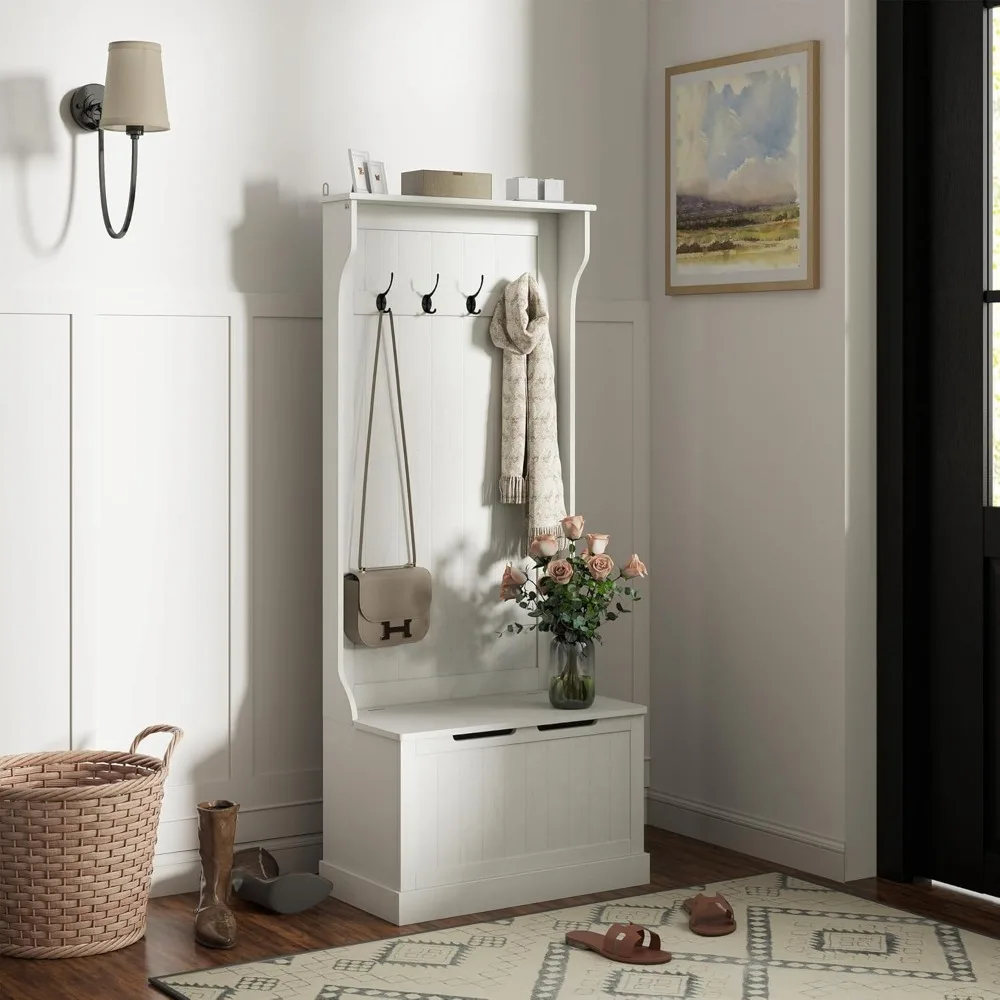
The entryway endures significant traffic and wear, making material durability particularly important. Consider how different materials will withstand daily use in your household. For example, families with young children might prefer the forgiveness of distressed woods that hide additional wear, while those in humid climates should prioritize woods with good dimensional stability.
For those specifically interested in wooden options, exploring wood entryway bench selections can provide insight into different wood types and their unique characteristics in entryway applications.
Functionality First: Assessing Your Entryway Needs
Before choosing furniture based purely on aesthetics, take time to evaluate how your entryway actually functions in daily life:
Usage Assessment:
– How many people regularly use this entrance?
– Is this the main entry point or a secondary entrance?
– What time of day sees the heaviest traffic?
– What seasonal items need accommodation?
Storage Requirements:
– How many coats and jackets need hanging space?
– Is shoe storage a priority?
– Do bags, backpacks, or sports equipment need designated spots?
– Are there small items (keys, mail, phones) that need a landing zone?
Special Considerations:
– Do you need seating for putting on/removing footwear?
– Is there a need for a mirror near the entrance?
– Would charging stations for electronic devices be useful?
– Do you need weather-specific storage (umbrella stand, boot tray)?
Common entryway challenges often have specific solutions:
– Limited space: Wall-mounted organizers and multi-functional pieces
– Lack of storage: Strategic combination of open and closed storage options
– Poor lighting: Furniture with lighter finishes; addition of mirrors and proper lighting
– High traffic: Extra-durable materials and finishes in high-wear areas
Finding the right balance between beauty and functionality ensures your entryway works for your lifestyle while still creating that stunning first impression. For practical inspiration, explore various practical entryway furniture ideas that combine rustic appeal with smart solutions for everyday challenges.
Design Harmony: Integrating Rustic Entry Furniture with Your Home’s Style
Rustic entry furniture doesn’t require a fully rustic home to work beautifully. The key is creating intentional harmony between your entryway and the rest of your living space:
With Modern/Contemporary Homes:
– Use rustic pieces as intentional contrast against sleeker elements
– Choose simplified rustic pieces with cleaner lines
– Limit the rustic palette to create a more curated look
– Use modern accessories with traditional rustic furniture pieces
With Traditional Homes:
– Focus on shared elements like craftsmanship and natural materials
– Choose rustic pieces with more refined finishes
– Connect styles through consistent wood tones or metal finishes
– Use traditional textiles with rustic furniture frames
With Transitional Spaces:
– Blend elements from both rustic and contemporary styles
– Maintain consistent scale between different style pieces
– Use color as a unifying element between different style zones
– Create gradual transitions rather than abrupt style changes

Color plays a crucial role in creating harmony. The warm neutrals and earth tones typical of rustic style can serve as a bridge between different design aesthetics throughout your home. Consider using paint colors in adjacent rooms that complement the natural tones of your rustic furniture.
Visual flow from the entryway to living spaces feels most natural when there are connecting elements – perhaps similar wood tones, complementary textures, or repeated design motifs that carry through from one space to the next.
Quality Craftsmanship: What to Look for in Well-Made Rustic Furniture
In rustic furniture, craftsmanship isn’t just about aesthetics – it directly impacts durability and function. Here’s what to examine when assessing quality:
Joinery Techniques:
– Dovetail joints in drawers indicate quality construction
– Mortise and tenon joints create strong, lasting connections
– Tongue and groove construction shows attention to detail
– Avoid pieces relying solely on glue, staples, or nails
Wood Quality Indicators:
– Consistent grain patterns suggest careful lumber selection
– Knots should be solid (not loose or falling out)
– Boards should feel substantial and have appropriate weight
– Avoid veneers masquerading as solid wood in rustic pieces
Finish Application:
– Even, consistent finish without drips or uneven spots
– Sealed surfaces in areas prone to moisture or wear
– Multiple finish layers for better protection
– Smooth finish application even on distressed surfaces
Hardware Quality:
– Substantial weight and feel to hinges, handles, and pulls
– Properly aligned installation without gaps or misalignments
– Smooth operation of moving parts (doors, drawers)
– Matching style that complements the overall design
When shopping online, look for detailed descriptions of construction methods, close-up images of joinery, and transparent information about materials. Quality rustic furniture represents an investment, but well-made pieces will serve you for decades while poorly constructed alternatives may need replacement within a few years.
For visual examples of quality craftsmanship, browsing collections like rustic hallway bench ideas can help you identify the hallmarks of well-constructed pieces.
Styling Your Rustic Entryway: Creating a Cohesive Look
Once you’ve selected your rustic entry furniture, thoughtful styling transforms the space from functional to fabulous:
Creating Focal Points:
– Position larger pieces like hall trees or console tables as anchors
– Use contrast (light vs. dark, rough vs. smooth) to draw the eye
– Install statement lighting that complements rustic elements
– Consider an accent wall with texture (wood planks, stone) behind furniture
Layering Textures:
– Combine different wood finishes for visual interest
– Add softness with textiles (runners, cushions, drapery)
– Incorporate natural elements like woven baskets or plants
– Mix metals with wood for dimension and contrast
Essential Rustic Accessories:
– Lighting: Iron sconces, wooden base lamps, candle lanterns
– Storage: Wooden crates, wicker baskets, canvas bins
– Wall Décor: Vintage mirrors, wooden signs, natural wreaths
– Textiles: Wool runners, canvas cushions, simple window treatments
Remember that rustic style embraces imperfection and authenticity. A perfectly matched, catalog-styled entryway often lacks the character and warmth that defines true rustic appeal. Allow for some variation and personalization to create a space that feels curated rather than purchased as a set.
Small Space Solutions: Rustic Style for Compact Entryways
Limited space doesn’t mean limiting style. Even the smallest entryway can embrace rustic charm with these space-maximizing strategies:
Wall-Mounted Solutions:
– Floating shelves with hooks underneath
– Wall-mounted fold-down desks that double as drop zones
– Narrow wall-hung cabinets for concealed storage
– Vertical coat rack systems that utilize height instead of width
Multi-Functional Furniture:
– Benches with interior storage compartments
– Mirror-coat rack combinations
– Narrow console tables with baskets underneath
– Wall-mounted drop-leaf tables that can be folded when not needed
Vertical Storage Opportunities:
– Floor-to-ceiling shelving units in narrow configurations
– Over-door organizers with rustic elements
– Stacked crates or boxes for modular storage
– High wall hooks for seasonal items
Visual Space Enhancers:
– Mirrors to reflect light and create depth
– Light colors for walls to contrast with darker rustic pieces
– Consistent wood tones to create visual flow
– Minimal accessories to prevent visual clutter
The key to small-space rustic style is selectivity – choosing fewer, better pieces that truly earn their place through both function and beauty. When choosing the perfect bench for a narrow hallway, prioritize pieces that maximize function without visually overwhelming the space. Browse small entryway bench options specifically designed for compact areas.
Investment Considerations: Budgeting for Quality Rustic Entry Furniture
Rustic entry furniture spans a wide price range, making it accessible at various budget levels. Understanding what drives price helps make informed investment decisions:
Material Factors:
– Solid hardwoods command higher prices than softwoods or engineered woods
– Reclaimed timber often costs more due to sourcing and processing
– Hand-forged metal elements increase cost over mass-produced alternatives
– Rare or exotic woods significantly impact price point
Construction Influences:
– Hand-crafted pieces with traditional joinery command premium prices
– Detailed carving or custom distressing increases labor costs
– Domestic production typically costs more than imported pieces
– Custom sizing or features add to base pricing
Finish Considerations:
– Multi-step finishing processes increase quality and cost
– Hand-applied finishes cost more than sprayed alternatives
– Specialized distressing techniques require skilled craftspeople
– Weather-resistant or extra-durable finishes add value for high-use areas
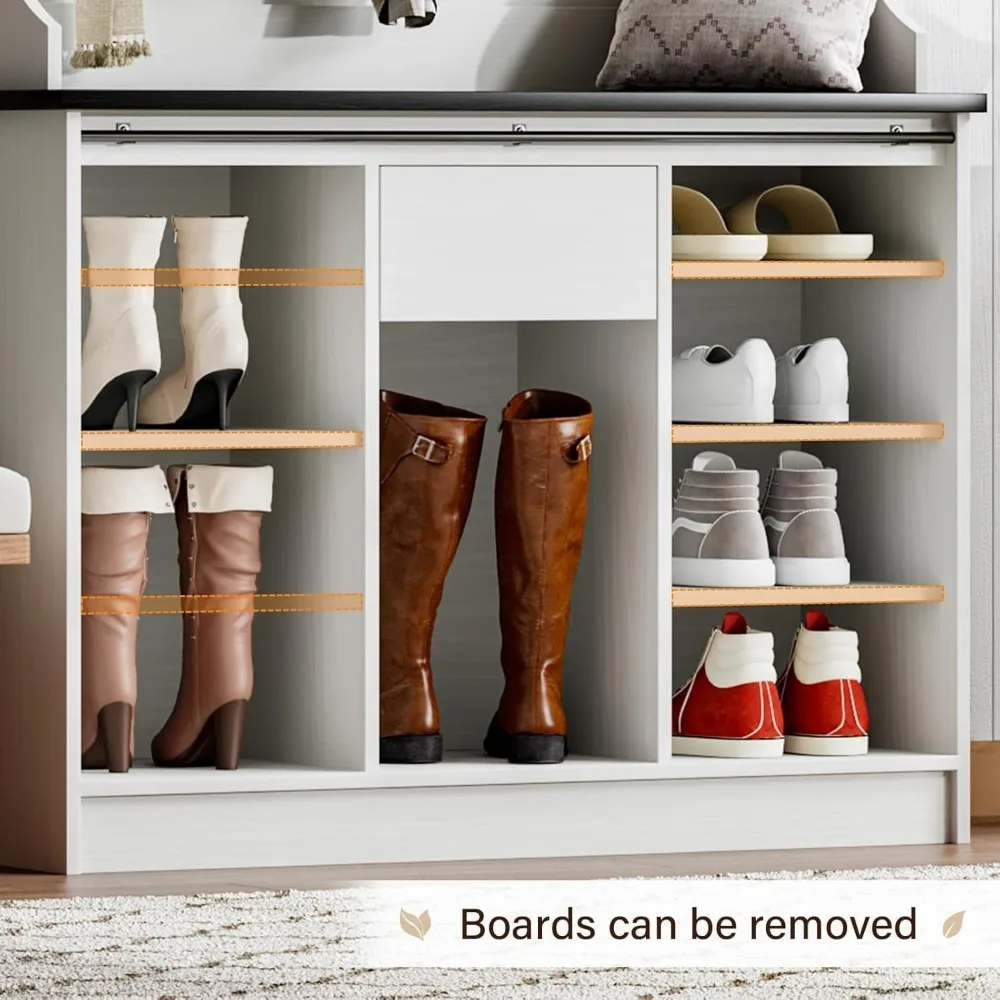
When budgeting, consider the cost-per-use calculation. A quality bench that serves your family daily for 15+ years may represent better value than a cheaper alternative requiring replacement every few years. Areas worth the splurge typically include primary pieces like hall trees or console tables, while accessories and secondary pieces might allow for more budget-conscious decisions.
Bench with Hooks and Storage, Entryway Hall Tree, Mudroom Bench with Cubbies, Mudroom Bench with Shoe Storage
$818.38 Select options This product has multiple variants. The options may be chosen on the product pageModern Entryway Bench, Wood Entryway Bench, Wood Mudroom Bench
$497.69 Select options This product has multiple variants. The options may be chosen on the product pageEntryway Coat Rack Bench, Entryway Hall Tree, Farmhouse Mudroom Bench, Mudroom Bench with Shoe Storage
$805.09 Select options This product has multiple variants. The options may be chosen on the product pageEntryway Bench with Cushion, Small Entryway Bench
$466.79 Select options This product has multiple variants. The options may be chosen on the product pageBench with Hooks and Storage, Entryway Coat Rack Bench, Entryway Hall Tree, Mudroom Bench with Shoe Storage, Mudroom Coat Rack Bench
$793.73 Select options This product has multiple variants. The options may be chosen on the product pageFarmhouse Entryway Bench, Modern Entryway Bench
$1,514.84 Select options This product has multiple variants. The options may be chosen on the product page
To protect your investment, follow manufacturer care instructions and establish simple maintenance routines like dusting with soft cloths, promptly addressing spills, and periodically re-applying protective finishes as needed.
Common Mistakes to Avoid When Selecting Rustic Entry Furniture
Even experienced decorators can make missteps when choosing rustic entry pieces. Avoid these common pitfalls:
Ignoring proper measurements: Selecting pieces too large or small for the space creates functional problems and visual imbalance. Always measure before purchasing and account for door clearances and traffic patterns.
Prioritizing look over function: Beautiful but impractical pieces quickly become frustrating. Consider your daily habits and storage needs before committing to a purely decorative piece.
Mixing incompatible rustic styles: Different interpretations of rustic (mountain lodge, farmhouse, Spanish rustic) don’t always blend well. Maintain consistency in the rustic sub-style you choose.
Underestimating durability needs: Entry areas endure significant wear. Choosing delicate finishes or lighter woods may lead to premature aging and damage in this high-traffic zone.
Overcrowding the entry: Too many pieces create a cluttered, unwelcoming first impression. Select fewer, more impactful pieces that allow for comfortable movement.
Neglecting lighting needs: Poorly lit entryways feel unwelcoming and make organization difficult. Ensure adequate lighting complements your rustic furniture.
Chasing trends over timeless appeal: The most sustainable approach is choosing classic rustic elements rather than trendy interpretations that may quickly feel dated.
Forgetting maintenance requirements: Some rustic finishes require specific care. Be realistic about the maintenance you’re willing to perform before selecting high-maintenance pieces.
FAQ: Answering Common Questions About Rustic Entry Furniture
How do I clean and maintain rustic wood furniture?
Most rustic wood pieces benefit from regular dusting with a soft cloth. Avoid harsh chemicals and opt for gentle wood cleaners appropriate for your specific finish. Apply quality furniture wax or polish according to manufacturer recommendations, typically 1-2 times yearly, to protect the finish and enhance natural beauty.
Can rustic entry furniture work in modern homes?
Absolutely! The contrast between sleek modern elements and textural rustic pieces creates visual interest. The key is balance – choose rustic pieces with simpler silhouettes, limit the quantity to create intentional focal points, and connect the styles through consistent color schemes.
What are signs of quality in rustic furniture?
Look for solid wood construction, traditional joinery methods (dovetail, mortise and tenon), smooth drawer operation, even finish application, and substantial hardware. Quality rustic pieces have heft and solidity, with attention to detail in both visible and hidden areas.
How much should I expect to invest in good rustic entry pieces?
Quality varies widely by material and construction. Entry-level solid wood benches might start around $200-300, while comprehensive hall trees from premium makers can exceed $1,000. Generally, allocating $400-700 for a primary entryway piece ensures reasonable quality without stretching to custom furniture price points.
What’s the difference between rustic and farmhouse styles?
While related, these styles have distinct differences. Rustic style emphasizes natural materials, rugged textures, and often features darker wood tones and metal accents. Farmhouse style benches for entryways typically incorporate more painted elements, lighter woods, and decorative details like beadboard or shiplap. Farmhouse tends toward a cleaner, more refined interpretation of country style.
Are there eco-friendly options for rustic furniture?
Yes! Reclaimed wood furniture repurposes timber from old structures, reducing environmental impact. Look for sustainable forestry certifications like FSC on new wood pieces. Many artisans specialize in eco-friendly rustic furniture using locally sourced materials and non-toxic finishes.
Rustic Entry Furniture Through the Seasons: Adaptability and Versatility
One of the strengths of rustic entry furniture is its ability to adapt seasonally while maintaining its core appeal:
Winter Adaptations:
– Add thicker cushions and throw blankets to benches
– Incorporate baskets for gloves, hats, and scarves
– Use lanterns with candles for warm, inviting light
– Create dedicated space for boot trays and wet gear
Spring Refreshes:
– Switch to lighter textiles in natural fibers
– Add fresh greenery or botanical elements
– Incorporate lighter baskets for seasonal storage
– Use natural elements like bird’s nests or botanical prints
Summer Styling:
– Minimize heavy accessories for a lighter feel
– Add blue and white accents for a fresh summer look
– Incorporate nautical or outdoor-inspired elements
– Create efficient systems for beach/pool gear
Fall Transformations:
– Bring in warmer colors through textiles and accessories
– Add rustic elements like pinecones or preserved leaves
– Incorporate amber-toned glass or warmer metals
– Create space for light jackets and transitional wear
The beauty of well-chosen rustic pieces is their ability to provide a consistent foundation while seasonal accessories create refreshed looks throughout the year. This adaptability makes quality rustic furniture an excellent long-term investment.
Rustic Entry Organization: Practical Solutions with Style
Maintaining an organized entryway doesn’t mean sacrificing rustic charm. These organizational solutions enhance both function and aesthetics:
Hidden Storage Solutions:
– Bench seating with flip-top storage
– Console tables with concealed drawers
– Cabinet doors that hide everyday clutter
– Hollow decorative elements that double as storage
Rustic-Appropriate Containers:
– Wooden crates with custom dividers
– Metal and wood baskets with labels or tags
– Vintage suitcases for seasonal storage
– Galvanized buckets for umbrellas or walking sticks
Mail and Paper Management:
– Wall-mounted wooden organizers with slots
– Repurposed wooden boxes for sorting
– Labeled bins for different household members
– Designated inbox/outbox system
Family-Friendly Systems:
– Assigned hooks at appropriate heights for different family members
– Color-coded or personalized storage containers
– Easy-access solutions that encourage use
– Durable materials that withstand daily handling
For more sophisticated storage options, exploring entryway bench drawers can provide inspiration for furniture that conceals clutter while maintaining rustic appeal.
Conclusion: Bringing Your Rustic Entryway Vision to Life
Selecting the perfect rustic entry furniture involves balancing multiple considerations – from practical space assessment and functionality needs to aesthetic preferences and quality evaluation. By thoughtfully addressing each aspect covered in this guide, you’ll create an entryway that not only makes a stunning first impression but serves your household beautifully for years to come.
Remember that rustic style celebrates authenticity, character, and craftsmanship. These qualities align perfectly with entryway spaces, which should feel both welcoming and functional. Whether you choose a comprehensive hall tree, a simple bench with storage, or a carefully curated combination of pieces, prioritizing quality materials and construction will ensure your rustic entry furniture becomes a beloved part of your home.
Take time to consider how you actually use your entryway, the specific storage needs of your household, and the overall aesthetic you wish to create. This thoughtful approach, rather than rushed decisions, leads to entryway spaces that truly enhance daily life while creating that warm, welcoming first impression that rustic style does so well.

